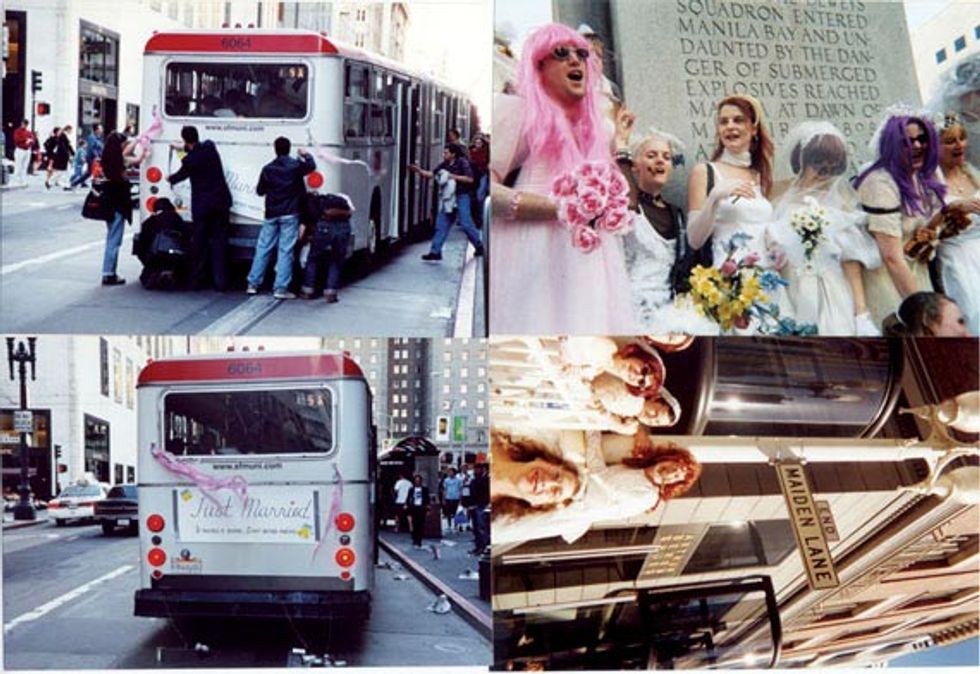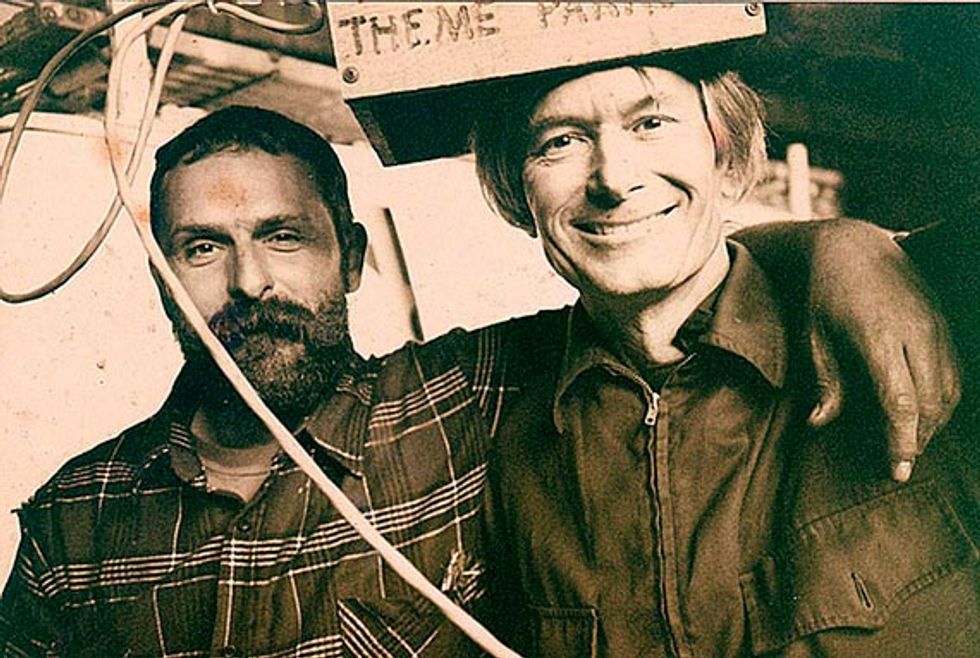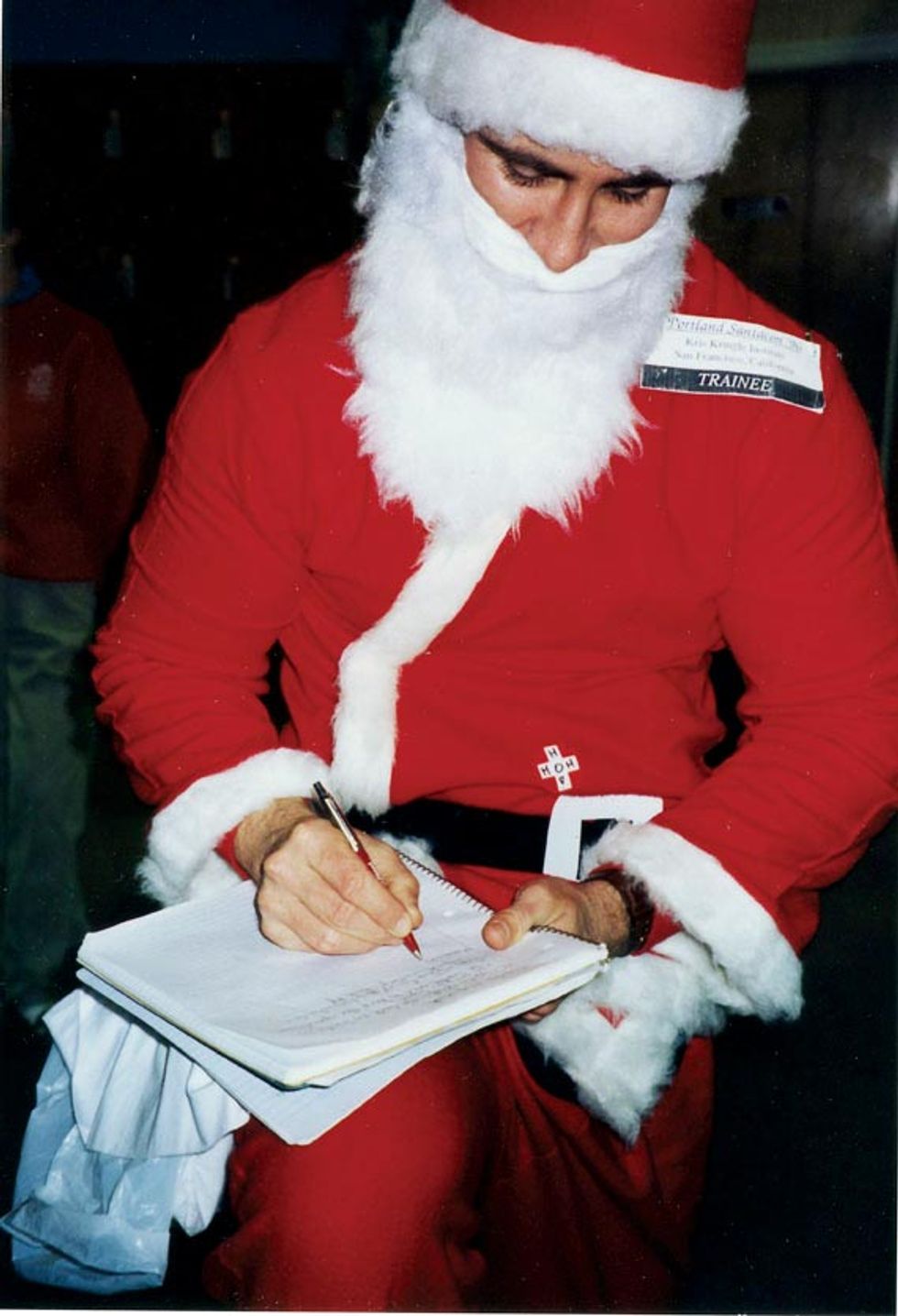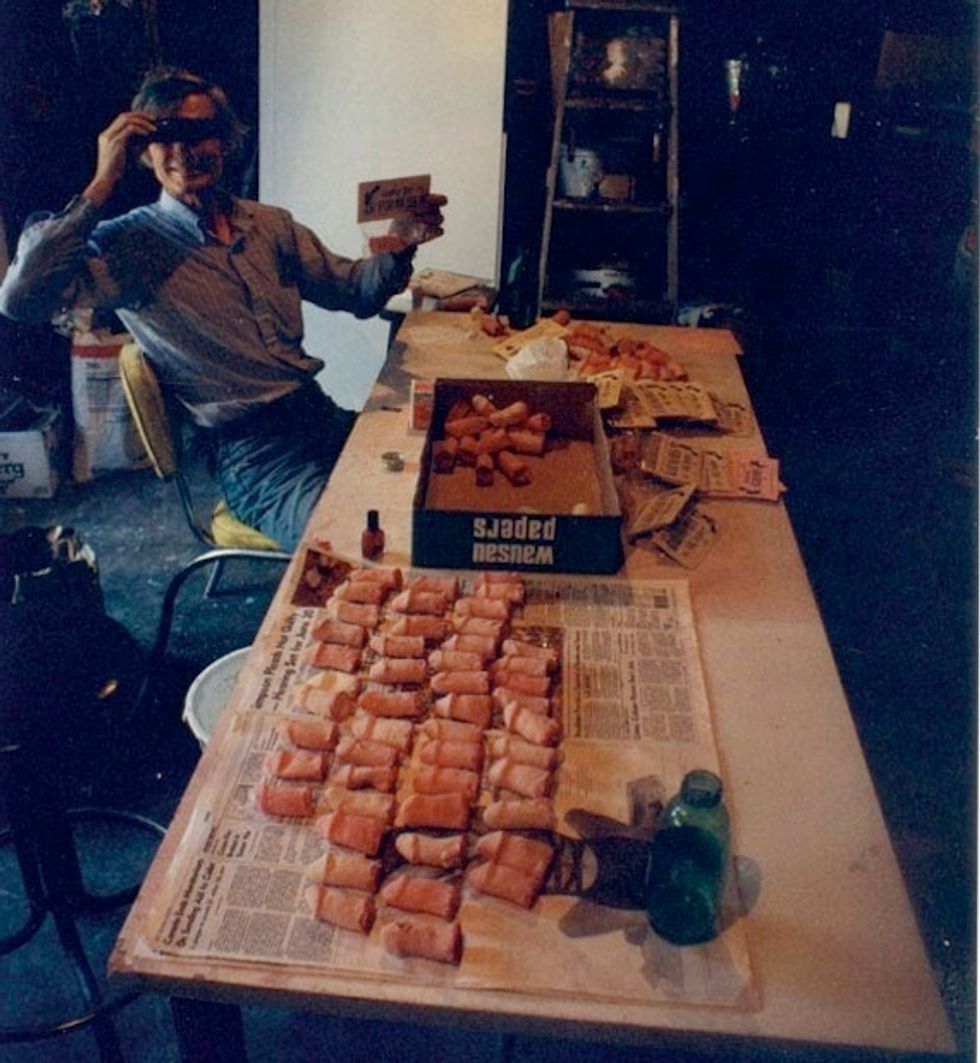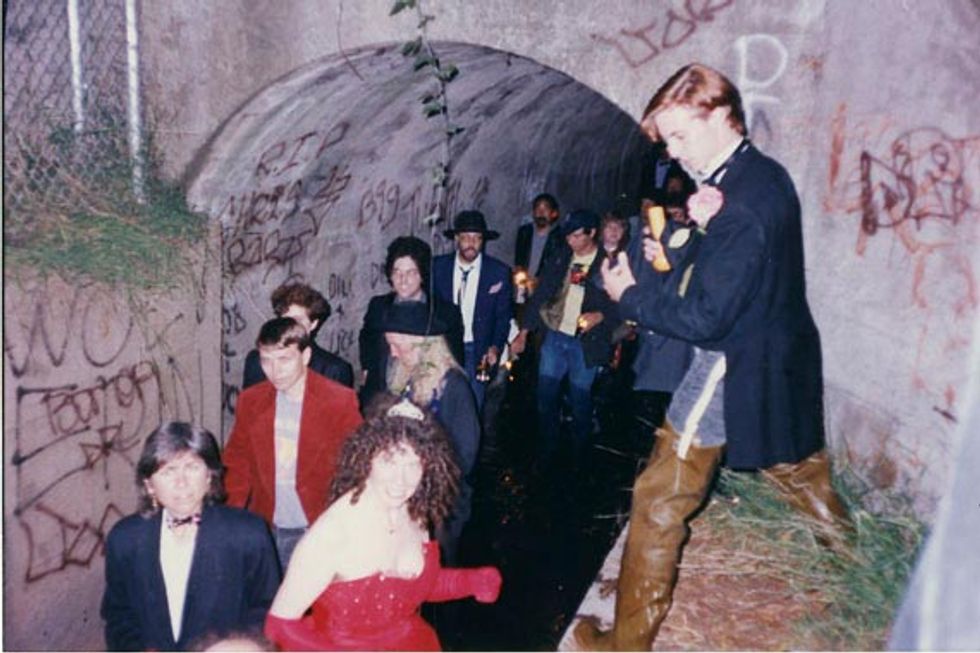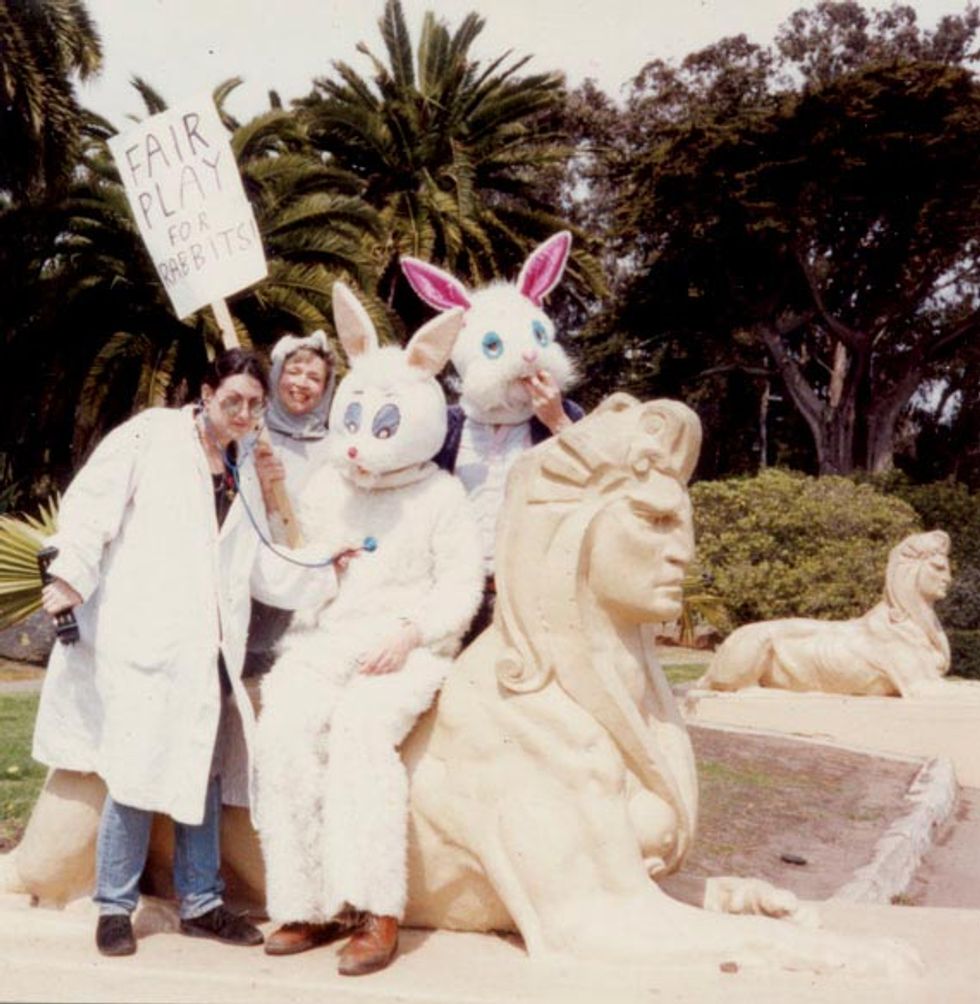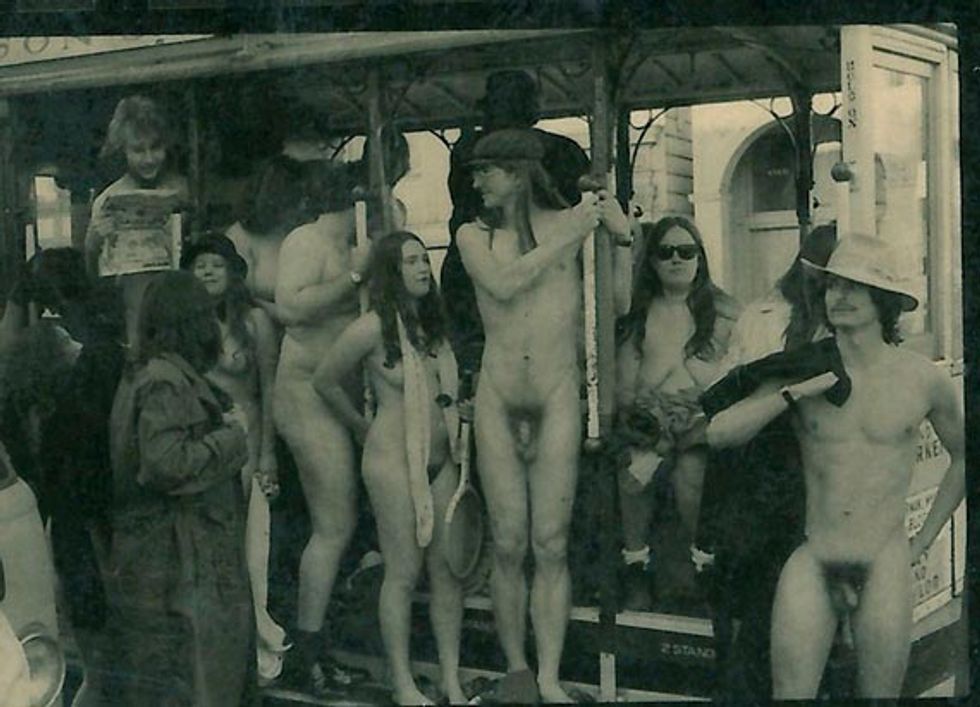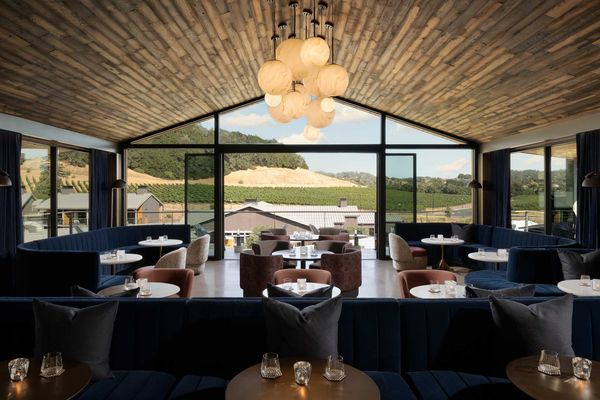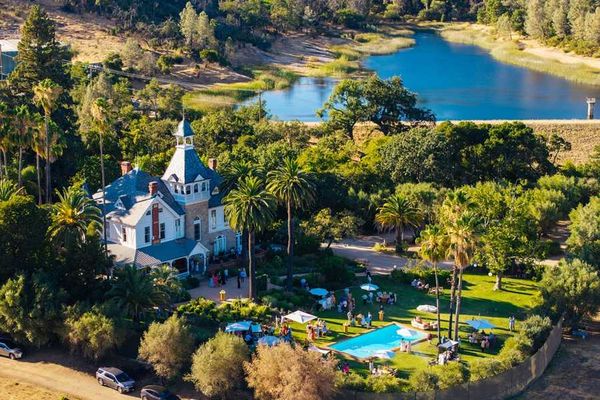Imagine a world where mayhem rules. Where tuxedoed men traverse our sewers and insane clown posses parade down Columbus Avenue. Where, under the cloak of darkness, hazmat-suited renegades take siege of abandoned government warehouses for bomb shelter potluck dinners, and singers in feather boas croon while a cigarette girl peddling rats on a serving tray turn BART into a Las Vegas lounge. For most, such scenes are the stuff of myth and Marvel Comics. For members of the SF Cacophony Society, it’s just another day in the life.
The Cacophony Society sprang from the now-defunct Suicide Club, started in 1977 by Gary Warne as a class at San Francisco State University’s free alternative school, Communiversity. Named after a Robert Louis Stevenson story about the exploits of jaded urbanites, the Suicide Club offered members a framework to play out dubious desires through urban adventures and street theater. Warne’s penchant for public pranks (think naked cable car rides and billboard hacking, plus death-defying stunts like climbing the Golden Gate Bridge) became calls to action for those seeking protest against escapist modern life in the form of art and culture born from creative mischief.
In 1986, four years after the club disbanded, former members founded the Cacophony Society. Monthly meetings sparked ideas for wacky events—like a Bastille Day celebration with guests in 18th century garb feeding cake to the homeless while guillotining political effigies—designed to “liberate the imagination, desires, dreams, and spirit,” according to founding member Lance Alexander. Cacophony’s raison d’être: culture jamming.
In a 1993 article, author and culture critic Mark Dery described culture jammers as “Groucho Marxists, ever mindful of the fun to be had in the joyful demolition of oppressive ideologies.” Cacophony Society’s hijinks gained traction in the ripe-for-moshing spirit of the ’90s, igniting chapters nationwide and exploding into the revelatory antiauthoritarian diversions we see today in SantaCon and Burning Man.
For the Society's 1995 Car Hunt, an Oldsmobile Cutlass Cruiser was reengineered and remote-controlled for a gun-toting chase in the desert. Photo via Nicole Rosenthal
North Beach resident John Law was one among the motley crew behind it all. The California-born, Michigan-raised, self-described angel (“Ask any of my exes,” he jokes) has been a character in the Bay Area arts scene for more than 30 years—scaling highway signs as part of the Billboard Liberation Front and hauling a flame-throwing cannon around Valencia Street on Halloween with the machine performance art crew Survival Research Labs. Now 54, with a “sweet-and-sour” beard, Law is a partner in the culture blog Laughing Squid. Last year, he indulged his fascination in bridge climbing (legally) on New York’s George Washington Bridge.
Having arrived in SF at the age of 17, Law quickly joined the city’s underground and would later become its de facto king: The guy who, dressed as the jolly Christmas icon, was “hanged” from an SF light pole during Santarchy—the slightly more sinister original of the now well-known pub crawl SantaCon—would go on to cofound Burning Man.
While Cacophonists have slowly gone the way of libraries in our digital age (they’re out there, but they’re hard to find), this May brought the release of Tales of the San Francisco Cacophony Society, edited by Law and fellow Cacophonists Carrie Galbraith and Kevin Evans. Worth its weight in gold for any budding prankster, the book recounts the spectacles of yore and offers advice (and a 12-step program) for modern-day mischief-makers. For added street cred, the foreword comes courtesy of Fight Club author Chuck Palahniuk, a Cacophony member who borrowed from Society shenanigans to inspire his hit book and film. Here, we catch up with Law as he relives the glory days.
Society co-founder John Law (left) with Michael Mikel in 1994. Photo via the Michael Mikel Collection
With this new book, you’ve officially outed everyone in the Cacophony Society. Have you considered fleeing the country?
John Law: Well, let’s just say that we checked with folks beforehand. Some people refused to have their real names in print. One was “Chad Mulligan,” who was the brain behind some of the best-known Cacophony pranks. Chad, along with Ann S. Thesia (which is clearly her real name), started the Salmon event that wriggles its way upstream each year at Bay to Breakers. Chad also came up with SantaCon (blame
him, not me!) and our biggest police-interdiction event in SF: 1994’s Kill Your TV, where Cacophony smashed 500 television sets in a variety of creative ways.
Another shy Cacophonist is “Jeffrey Spaulding.” He is a well-known local bureaucrat nowadays who completely denies any past illegal or illicit involvement in Cacophony or Suicide Club. He gets ink annually for a long-lived, well-loved, and completely legitimate annual charity event in San Francisco. You get to guess which one.
Were all Cacophonists full-time pandemonium seekers, or were there
any “normal” people in the bunch?
All of us were pretty much normal or at least had normal jobs and careers. If you don’t believe me, read Chuck Palahniuk’s great foreword to our book. Chuck was a diesel mechanic when he joined Portland Cacophony and when he wrote Fight Club. He notes that his pals in Cacophony were regular working folks, most with dullish day jobs. Cacophony was their way of getting together and exploring the weirder, more exciting world of noncommercial pranking.
Any interesting anecdotes about Palahniuk that you remember?
During SantaCon No.3 in 1996, there were close to 100 police following hundreds of knackered Saint Nicks around downtown Portland. PPD had evidently been tipped off by SFPD because of the arrests at SF SantaCon the year before. As one of the organizers of the Portland event, I was pretty paranoid when I deplaned at PDX with 70 Frisco Santas in full crimson regalia, and we were met by officers from the PPD Intelligence Squad and a SWAT van.
Santa Chuck Palahniuk at SantaCon Portland, 1996
Our phones had been tapped—PPD knew our itinerary better than we did. So when a fit and intense-looking Santa with a notepad started asking me a bunch of prying questions, I insisted he show me his driver’s license. Well, this Santa had just published his first novel. After convincing me he wasn’t a police plant, he gave me a shiny new hardback copy of Fight Club.
What about SF fostered Cacophony?
Oscar Wilde said, “It is an odd thing, but everyone who disappears is said to be seen in San Francisco.” We are the home of Emperor Norton, the Beats, [19th-century sideshow performer] Oofty Goofty, [underground architecture firm] Ant Farm, [psychedelic drag-queen troupe] The Cockettes, steam beer, hippies, Dead Kennedys, and Sisters of Perpetual Indulgence. In the very best sense, San Francisco is the “land of fruits and nuts” as various pundits have pointed out over the years.
When did Cacophony reach its height?
The years between 1992 and 1997 produced some of the most memorable events. Even so, a later crew of Cacophonists, who became known as Cacophony 2.0 starting in 1998, created some doozies like the Pigeon Roast. The young meat lovers roasted squabs bought in Chinatown on Weber grills, directly across from a PETA protest in Union Square, handing the tender morsels out to the public. The police actually had to protect the innocent carnivores from physical attacks by enraged vegans. These kids—they’re in their 40s now—were instrumental in many of the proto-flash mobs (Brides of March, Pillow Fight, Cardboard Warfare, Bring Your Own Big Wheel) of the early aughts.
Michael Mikel inspects Lorena Bobbit Penis Chew Toys destined for covert store placement
Cacophony had a national impact and laid the base for the underground art and hacking movements of the past three decades. How did it spread so far and fast?
There is no stopping a dangerous and stupid idea! Galbraith was taking time off from teaching art in Venice on a Fulbright scholarship and was inspired by obscure Russian films and novels to create Zone Trip—basically a road trip to anywhere, with travelers entering a zone where literally anything could happen. The first Zone Trip was to LA. The fourth was the first Burning Man at Black Rock Desert in 1990.
SF Cacophony was present during, and part of, the birth of Internet culture. As more people went online, Cacophony and Burning Man started to go viral, as they now say. Burning Man—a whimsical anarchist gathering in its early iteration—became the holiday of choice for well-heeled tech workers as they learned about it online. Cacophony, which at its core was really a delivery system for ideas and events as well as a social network, became obsolete as a mechanism and was supplanted by the Internet.
What were some of your most dangerous capers?
Danger is, like so many things in life, a very subjective thing. Evans, Galbraith, Eric Chipchase, Corey Keller, and others, had a subgroup: Bolt Action Rifle Club (BARC). They did a lot of shooting. This might seem dangerous to those unfamiliar with rifles, but in fact
it was very safe.
This klatch was the first theme camp at Burning Man, as well as the first of many weapons-based activities. Range control was enforced, so participating in a BARC outing was as secure as walking down the street. A few years later, we held the Car Hunt out on Blue Wing Playa in Pershing County, Nevada. Cacophony partnered with extreme-art cabal PeopleHater to reengineer and control remotely a 4,000-pound Oldsmobile Vista Cruiser station wagon and hunt it down using live ammo fired from moving vehicles. This looked very dangerous.
Sewer Tours called for formal wear in the '90s
What’s the best prank CS pulled off?
The most successful media prank was engineered by Dwayne Neutron (Peter Doty). He organized a protest of the showing of
Fantasia at the Castro Theatre and the video release at Blockbuster.
The umbrella organization was CAFE (Coalition Against Fantasias Exhibition) and sub groups include SPASM (Sensitive Parents Against Scary Movies), BADRAP (Bay Area Drought Relief Alliance Party—protesting the water-wasting Mickey Mouse-Sorcerers Apprentice segment), and others. The succeeding press frenzy culminated in a Time magazine cover article on “whiny identity politics in San Francisco.”
Have any gone horribly wrong?
Uhh…Burning Man? Kidding! It really is a good thing to have a place (far away from more sensitive citizens) to put all those naked attorneys and accountants on ecstasy.
You’re no longer involved in
Burning Man. What happened?
Many of us dropped out of Burning Man when it began to require rules and regulations. Early BM was a Temporary Autonomous Zone (TAZ), where there were no bosses and no bossed. This type of social organizing is the most rare and magical. During the first years on
the desert, people were expected not to be dicks and, on the whole, were not dicks. Imagine a place of total real freedom. That was it. For the event to survive, the numbers grew to huge proportions, and it became something else. Comparing the early days to now is like comparing a persimmon to one of those 2,000-pound pumpkins
they grow every year.
Cacophonist bunnies doled out carrots to kids on Easter, berating their parents for letting them eat chocolate.
You wrote a collection of short stories about bridge climbs called The Space Between. How many times have
you climbed the Golden Gate?
I lost track at 100 back in 1980. Climbing and exploring the urban environment was a big part of the Suicide Club and continued on into the Cacophony days. The first event I ever organized was a walking tour of the Oakland sewers.
Where have all the Cacophonists gone?
We all work at your office. Check out the water cooler! There was no official end to the group. It just faded away as it became outmoded in the age of immediate communication and the meme. Former members are all around. Some are captains of industry, artists both obscure and noted, office workers, tradesmen, costumers and set designers, politicians, reality TV characters, robot scientists, criminals, architects and industrial designers, the homeless, government workers, retirees. You name it.
Cacophony’s MO was to “live each day as though it were your last,” and the book urges readers to start their own clever chaos. How does one recreate Cacophony?
Well, some kids—maybe yours—are doing just that right now. And if you think they’re gonna tell a bunch of smelly old people what they’re up to, you’re in for a surprise. They probably don’t call it Cacophony, but similar groups have existed on the fringes of mainstream society forever. Our group was never the most competent of organizations, and as an actual working group, it’s been gone for a while. The Internet pretty much made our paper newsletter of local events unnecessary, even quaint in retrospect. The people conspiring to create pranks and participatory events now will be using the new tools of this age, just as we used Kinko’s, the USPS, phone trees, smoke signals, and bongo drums. It’s all online and instantaneous now. That provides myriad new ways of organizing.
The Suicide Club's infamous naked cable car stunt, 1977
How many times have you been arrested?
Under what name?
Have there been any repercussions since you made your identities public?
I get offered drinks more often. Too bad my doctor made me give up alcohol. I think that most of my friends and fellows have weathered any terrible backlash for their involvement. Anyway, the statute of limitations on most indiscretions is well past.
What’s next for Cacophony? Is there still new territory to disrupt?
Cacophony, despite the literal meaning of the word, was never, in my opinion, a disruptive force so much as an idea or even a philosophy about how to live life through direct involvement. Most human engagements, not just day jobs or work-related commerce, are usually monetary exchanges. You pay to be entertained, engaged, involved. Movies, theater, TV, dating services, Internet porn, exercise, communication—all are traded for cold hard cash. Cacophony was free. Stupid and dangerous sometimes. Liberating and even transcendent at its best. It was never a commodity.
Experience the SF Cacophony Society's antics in the flesh, with John Law and Fight Club author Chuck Palahniuk, at the Commonwealth Club's Creating Culture from Mayhem discussion, Monday, September 23.
This article was publsihed in 7x7's July/August issue. Click here to subscribe.



